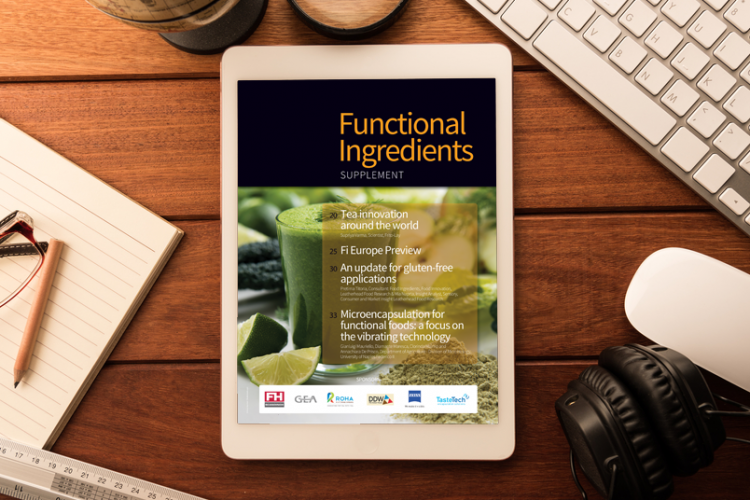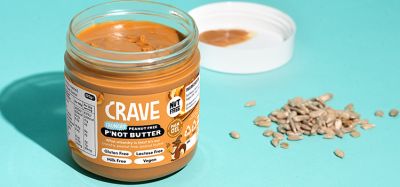Functional Ingredients supplement 2013
- Like
- Digg
- Del
- Tumblr
- VKontakte
- Buffer
- Love This
- Odnoklassniki
- Meneame
- Blogger
- Amazon
- Yahoo Mail
- Gmail
- AOL
- Newsvine
- HackerNews
- Evernote
- MySpace
- Mail.ru
- Viadeo
- Line
- Comments
- Yummly
- SMS
- Viber
- Telegram
- Subscribe
- Skype
- Facebook Messenger
- Kakao
- LiveJournal
- Yammer
- Edgar
- Fintel
- Mix
- Instapaper
- Copy Link
Posted: 4 November 2013 | Supriya Varma, Pretima Titoria, Mia Naprta, Gianluigi Mauriello, Diamante Maresca, Clorinda Malmo, Annachiara De Prisco | 2 comments
Tea innovation around the world
An update for gluten-free applications
Microencapsulation for functional foods: a focus on the vibrating technology


This free to view Functional Ingredients supplement is sponsored by TasteTech, Carl Zeiss, DDW, ROHA, GEA Group and FH SCANDINOX.
- Tea innovation around the world
Author: Supriya Varma, Scientist, Frito-Lay
Tea drinking has been an integral part of many cultures. The legend goes that the Chinese Emperor Shen Hung was a renowned herbalist. He was boiling his drinking water when leaves from a nearby tea shrub flew into his cauldron; he tasted the brew and introduced tea to the rest of the world. Historians have documented that tea was present as a beverage during Confucius’s era (circa 551 – 479 BC) and then gained popularity in the Han dynasty (206 BC – 220 AD). By the time the Tang dynasty came into power (618 – 906 AD), tea was recognised as the national drink of China. In the late 8th century, the growing popularity of tea drinking led author Lu Yu to write a book called as Ch’a Ching (Tea Classic)… - An update for gluten-free applications
Authors: Pretima Titoria, Consultant: Food Ingredients, Food Innovation / Mia Naprta, Insight Analyst, Sensory, Consumer and Market Insight, Leatherhead Food Research
Gluten sensitivity or gluten intolerance are two terminologies that are becoming common in the current global dietary world. They represent a spectrum of disorders in which the gluten component has an adverse effect on the body. Bloating, abdominal pain, diarrhoea, muscular disturbances and bone/joint pain are some of the symptoms faced by affected people. In some people, lifelong gluten intolerance / insensitivity can lead to coeliac disease, which represents the damage done to the small intestine brought about by gliaden, which is part of the gluten proteins, and is a large part of wheat, rye and barley. It is believed that strict adherence to a gluten-free diet brings complete resolution of symptoms… - Microencapsulation for functional foods: a focus on the vibrating technology
Authors: Gianluigi Mauriello, Diamante Maresca, Clorinda Malmo and Annachiara De Prisco, Department of Agriculture – Division of Microbiology, University of Naples Federico II
Microencapsulation is a promising technology useful for preserving bacterial cells and bioactive compounds widely used for many industrial applications including food, pharmaceuticals and agriculture. The process allows the entrapping of micro-size core particles of solids and droplets of liquid or gases in a homogeneous or heterogeneous matrix. Due to the advantages offered by this technology, such as protection of unstable and sensitive materials from environmental conditions, controlled and targeted release, odour and taste masking, microencapsulation is widely employed in the food industry… - Show Preview: Food Ingredients Europe / Natural Ingredients
Frankfurt welcomes the world to Fi Europe & Ni 2013








you published a nice articles
i am doing M.sc food and nutrition i want some reviews related to gluten free flour and brain development foods for my project so please sent me that type of articles
Hi Shobna, if you search for “gluten free” you will find a number of articles and news stories which might help: http://www.newfoodmagazine.com/?s=gluten+free&submit=
A search for “brain food” produces the following results, but I’m not sure how relevant these are to your studies: http://www.newfoodmagazine.com/?s=brain+food&submit=